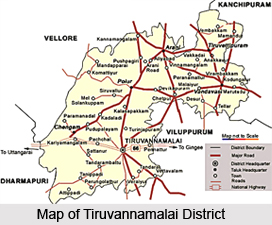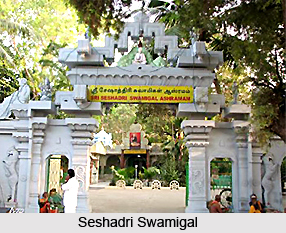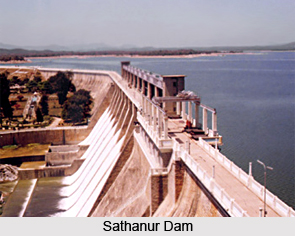 Tiruvannamalai district is one of the most venerated places in the state of Tamil Nadu in India. In ancient times, the term `Annamalai` meant an inaccessible mountain and the word `Thiru` was prefixed to signify its greatness, and paired with the two terms, it is called Tiruvannamalai. The district of Tiruvannamalai came into existence on the 30th of September 1989 after the bifurcation of the formerly North Arcot District.
Tiruvannamalai district is one of the most venerated places in the state of Tamil Nadu in India. In ancient times, the term `Annamalai` meant an inaccessible mountain and the word `Thiru` was prefixed to signify its greatness, and paired with the two terms, it is called Tiruvannamalai. The district of Tiruvannamalai came into existence on the 30th of September 1989 after the bifurcation of the formerly North Arcot District.
Location of Tiruvannamalai district
The district of Tiruvannamalai in the Tamil Nadu state is placed in between eleven degree fifty five minutes and thirteen degree fifteen minutes to the North latitude and seventy eight degree twenty minutes and seventy nine degree fifty minutes to the East longitude. It is bounded to the north and west by Vellore District, to the southwest by Dharmapuri District, to the south by Viluppuram District and to the east by Kanchipuram District.
History of Tiruvannamalai district
In ancient times, the term `Annamalai` signified an inaccessible mountain, while the word `Thiru` was prefixed to mean its greatness, and together with the two terms, it is known as Tiruvannamalai. The history of this district dates back to the early Chola period i.e. the period of Aditya I and Parantaka I when the Chola Empire had expanded northwards to include practically the wholes of Tondaimandalam. A short period of the supremacy of Pandya Dynasty over this district is indicated by the inscriptions of the Pandyas of the second empire such as Jatavaraman Srivallabha and Tribhuvanachakravartin Kulasekhara in the thirteenth century AD. The Hoysalas under Vira Vallaladeva (Ballala III) also ruled over this area around A.D. 1340, an indication that the Hoysala power continued to influence Tamil politics even after the Muslim invasions of Malik Kafur. After the Hoysalas, Tiruvannamalai came under the rule of the Vijayanagar rulers, whose southern invasions under Kampana are well-known and led to the establishment of Vijayanagar Empire over practically the whole of Tamil Nadu state. After the Nayak rule, this region seemed to have slowly passed into the hands of the British except for a brief period of subordination to the Mysore Odeyars in A.D. 1816.

After the independence of India in the year 1947, the present district of Tiruvannamalai was under North Arcot District. The civil district of North Arcot was divided into Vellore district and Tiruvannamalai district in the month of October 1989. The first collector of this district was Thiru. P.Kolappan (IAS). On the whole, the district of Tiruvannamalai is traditionally rich in spiritual and historic values.
Geography of Tiruvannamalai district
The Tiruvannamalai District is located between eleven degree fifty minutes and thirteen degree fifteen minutes to the north latitude and seventy eight degree twenty minutes and seventy nine degree fifty minutes to the east longitude. It is having its borders as the district of Vellore to the north and west, district of Dharmapuri to the southwest, district of Villupuram to the south and the district of Kanchipuram to the east. The total area covered by the district is six thousand one hundred and ninety one square kilometers. The maximum temperature experienced by this district is 36.7 degree Celsius and the minimum temperature is 22.4 degree Celsius.
Administration of Tiruvannamalai district
The administration of the district of Tiruvannamalai is having the district collector as the head. The collector of this district is assisted by a number of officers in carrying out the general work of administration. The district has two revenue divisions, seven revenue taluks, fifty two revenue firkas and one thousand sixty seven revenue villages. In the district of Tiruvannamalai there are four municipalities, eighteen panchayat unions, ten special panchayats and eight hundred and sixty village panchayats.
 Tourism of Tiruvannamalai district
Tourism of Tiruvannamalai district
Tiruvannamalai District is known for everlasting peace and divine with the proud possession of the holy shrine of Lord Arunachaleswara and Ashrams. It is considered superior to all the other eminent shrines. Tiruvannamalai confers salvation to one who merely thinks of it. The temples in this district form the major source of tourist attraction and it draws a large number of pilgrims from different parts of the state. One of the prominent places of interest is the Sri Seshadri Swamigal Ashram. Mahan Sri Seshadri Swamigal lived in the later half of the 20th Century. This ashram is one of the holy places in this district where people from all over the world visit. It is located close to the Sri Ramana Ashram. The Garden in this Ashram attracts the people who visit here. Another ashram of prominence is the Sri Ramana Ashram. Mahan Sri Ramana maharishi lived here. It is one of the holy places in this town which is visited by people from different places.
Apart from the temples and ashrams, there are several other places of tourist interest in this district which also includes the Sathanur Dam. This dam is major dams constructed across the Pennaiyar River among the Chennakesava Hills. The Sathanur Dam was erected during the year 1958 and it possesses a very beautiful parks and a mini zoo. The garden here is dotted with colourful statues and a swimming pool and a crocodile farm is also at this place. Another well-known destination in this district is the Jawadhu Hills. It is located at a distance of seventy five kilometres from Tiruvannamalai. The cliffs and precipices of hills allure and excite the visiting tourists. Some of the major attractions of the Jawadhu hills are Komutteri Lake, Beema Falls, Amirthi Forest, Kavalur Observatory and the Glass House.






